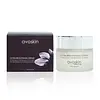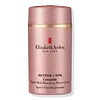What's inside
What's inside
 Key Ingredients
Key Ingredients

 Benefits
Benefits

 Concerns
Concerns

 Ingredients Side-by-side
Ingredients Side-by-side

Water
Skin ConditioningCaprylic/Capric Triglyceride
MaskingGlycerin
HumectantAlpha-Arbutin
AntioxidantPentylene Glycol
Skin ConditioningCapryloyl Glycerin/Sebacic Acid Copolymer
Skin ConditioningButyrospermum Parkii Butter
Skin ConditioningSqualane
EmollientDiheptyl Succinate
EmollientCetearyl Alcohol
EmollientHydroxyethyl Acrylate/Sodium Acryloyldimethyl Taurate Copolymer
Emulsion StabilisingPropanediol
SolventGlyceryl Stearate
EmollientPEG-100 Stearate
1,2-Hexanediol
Skin ConditioningCarbomer
Emulsion StabilisingSodium Hydroxide
BufferingCaprylhydroxamic Acid
Butylene Glycol
HumectantAnthemis Nobilis Flower Extract
MaskingGlycyrrhiza Uralensis Root Extract
Skin ConditioningMacadamia Ternifolia Seed Oil
EmollientHydrogenated Lecithin
EmulsifyingPropylene Glycol
HumectantPolysorbate 20
EmulsifyingRetinol
Skin ConditioningBrassica Campestris Sterols
EmollientCholesterol
EmollientCeteth-3
EmulsifyingCeteth-5
EmulsifyingAluminum/Magnesium Hydroxide Stearate
Emulsion StabilisingTocopheryl Acetate
AntioxidantPotassium Cetyl Phosphate
EmulsifyingChitosan
Disodium EDTA
Water, Caprylic/Capric Triglyceride, Glycerin, Alpha-Arbutin, Pentylene Glycol, Capryloyl Glycerin/Sebacic Acid Copolymer, Butyrospermum Parkii Butter, Squalane, Diheptyl Succinate, Cetearyl Alcohol, Hydroxyethyl Acrylate/Sodium Acryloyldimethyl Taurate Copolymer, Propanediol, Glyceryl Stearate, PEG-100 Stearate, 1,2-Hexanediol, Carbomer, Sodium Hydroxide, Caprylhydroxamic Acid, Butylene Glycol, Anthemis Nobilis Flower Extract, Glycyrrhiza Uralensis Root Extract, Macadamia Ternifolia Seed Oil, Hydrogenated Lecithin, Propylene Glycol, Polysorbate 20, Retinol, Brassica Campestris Sterols, Cholesterol, Ceteth-3, Ceteth-5, Aluminum/Magnesium Hydroxide Stearate, Tocopheryl Acetate, Potassium Cetyl Phosphate, Chitosan, Disodium EDTA
Water
Skin ConditioningCaprylic/Capric Triglyceride
MaskingGlycerin
HumectantDiisopropyl Adipate
EmollientPentylene Glycol
Skin ConditioningDimethicone
EmollientButylene Glycol
Humectant4-T-Butylcyclohexanol
Masking1,2-Hexanediol
Skin ConditioningAcetyl Tetrapeptide-11
Skin ConditioningAcetyl Tetrapeptide-9
Skin ConditioningAmmonium Acryloyldimethyltaurate/Beheneth-25 Methacrylate Crosspolymer
Emulsion StabilisingBisabolol
MaskingButyrospermum Parkii Butter
Skin ConditioningC13-14 Isoparaffin
EmollientCaprylhydroxamic Acid
Carbomer
Emulsion StabilisingCeramide NP
Skin ConditioningCetearyl Dimethicone Crosspolymer
Dimethyl Isosorbide
SolventDisodium EDTA
Glyceryl Stearate
EmollientGlycine Soja Oil
EmollientHydroxypinacolone Retinoate
Skin ConditioningLaureth-7
EmulsifyingLimnanthes Alba Seed Oil
Skin ConditioningMacadamia Integrifolia Seed Oil
Skin ConditioningMica
Cosmetic ColorantMoringa Oleifera Seed Oil
EmollientPEG-100 Stearate
Phytosphingosine
Skin ConditioningPolyacrylamide
Polysorbate 20
EmulsifyingRetinol
Skin ConditioningSodium Hyaluronate
HumectantTromethamine
BufferingZingiber Officinale Root Extract
MaskingParfum
MaskingTocopherol
AntioxidantCI 77491
Cosmetic ColorantWater, Caprylic/Capric Triglyceride, Glycerin, Diisopropyl Adipate, Pentylene Glycol, Dimethicone, Butylene Glycol, 4-T-Butylcyclohexanol, 1,2-Hexanediol, Acetyl Tetrapeptide-11, Acetyl Tetrapeptide-9, Ammonium Acryloyldimethyltaurate/Beheneth-25 Methacrylate Crosspolymer, Bisabolol, Butyrospermum Parkii Butter, C13-14 Isoparaffin, Caprylhydroxamic Acid, Carbomer, Ceramide NP, Cetearyl Dimethicone Crosspolymer, Dimethyl Isosorbide, Disodium EDTA, Glyceryl Stearate, Glycine Soja Oil, Hydroxypinacolone Retinoate, Laureth-7, Limnanthes Alba Seed Oil, Macadamia Integrifolia Seed Oil, Mica, Moringa Oleifera Seed Oil, PEG-100 Stearate, Phytosphingosine, Polyacrylamide, Polysorbate 20, Retinol, Sodium Hyaluronate, Tromethamine, Zingiber Officinale Root Extract, Parfum, Tocopherol, CI 77491
Ingredients Explained
These ingredients are found in both products.
Ingredients higher up in an ingredient list are typically present in a larger amount.
1,2-Hexanediol is a synthetic liquid and another multi-functional powerhouse.
It is a:
- Humectant, drawing moisture into the skin
- Emollient, helping to soften skin
- Solvent, dispersing and stabilizing formulas
- Preservative booster, enhancing the antimicrobial activity of other preservatives
Butylene Glycol (or BG) is used within cosmetic products for a few different reasons:
Overall, Butylene Glycol is a safe and well-rounded ingredient that works well with other ingredients.
Though this ingredient works well with most skin types, some people with sensitive skin may experience a reaction such as allergic rashes, closed comedones, or itchiness.
Learn more about Butylene GlycolThis ingredient is also known as shea butter. It is an effective skin hydrator and emollient.
Emollients help soothe and soften your skin. It does this by creating a protective film on your skin. This barrier helps trap moisture and keeps your skin hydrated. Emollients may be effective at treating dry or itchy skin.
Shea butter is rich in antioxidants. Antioxidants help fight free-radicals, or molecules that may harm the body. It is also full of fatty acids including stearic acid and linoleic acid. These acids help replenish the skin and keep skin moisturized.
While Shea Butter has an SPF rating of about 3-4, it is not a sunscreen replacement.
Shea butter may not be fungal acne safe. We recommend speaking with a professional if you have any concerns.
Learn more about Butyrospermum Parkii ButterCaprylhydroxamic Acid is a chelating agent.
Chelating agents help prevent metal ions from binding to other ingredients. This helps prevent unwanted reactions and effects from using the product.
Caprylhydroxamic Acid is often used with natural antimicrobial products as an alternative to preservatives.
Learn more about Caprylhydroxamic AcidThis ingredient is an emollient, solvent, and texture enhancer. It is considered a skin-softener by helping the skin prevent moisture loss.
It helps thicken a product's formula and makes it easier to spread by dissolving clumping compounds.
Caprylic Triglyceride is made by combining glycerin with coconut oil, forming a clear liquid.
While there is an assumption Caprylic Triglyceride can clog pores due to it being derived from coconut oil, there is no research supporting this.
Learn more about Caprylic/Capric TriglycerideCarbomer is a polymer of acrylic acid. Its main role is to create a gel consistency.
A high amount of carbomer can cause pilling or balling up of products. Don't worry, most products contain 1% or less of carbomer.
Disodium EDTA plays a role in making products more stable by aiding other preservatives.
It is a chelating agent, meaning it neutralizes metal ions that may be found in a product.
Disodium EDTA is a salt of edetic acid and is found to be safe in cosmetic ingredients.
Learn more about Disodium EDTAGlycerin is already naturally found in your skin. It helps moisturize and protect your skin.
A study from 2016 found glycerin to be more effective as a humectant than AHAs and hyaluronic acid.
As a humectant, it helps the skin stay hydrated by pulling moisture to your skin. The low molecular weight of glycerin allows it to pull moisture into the deeper layers of your skin.
Hydrated skin improves your skin barrier; Your skin barrier helps protect against irritants and bacteria.
Glycerin has also been found to have antimicrobial and antiviral properties. Due to these properties, glycerin is often used in wound and burn treatments.
In cosmetics, glycerin is usually derived from plants such as soybean or palm. However, it can also be sourced from animals, such as tallow or animal fat.
This ingredient is organic, colorless, odorless, and non-toxic.
Glycerin is the name for this ingredient in American English. British English uses Glycerol/Glycerine.
Learn more about GlycerinGlyceryl Stearate is a mix of glycerin and stearic acid.
It is used to stabilize the mixing of water and oil ingredients. By preventing these ingredients from separating, it can help elongate shelf life. It can also help thicken the product's texture.
As an emollient, it helps soften skin and supports barrier-replenishing ingredients.
In cosmetics, Glyceryl Stearate is often made from vegetable oils or synthetically produced.
This ingredient may not be fungal-acne safe
Fun fact: The human body also creates Glyceryl Stearate naturally.
Learn more about Glyceryl StearatePeg-100 Stearate is an emollient and emulsifier. As an emollient, it helps keep skin soft by trapping moisture in. On the other hand, emulsifiers help prevent oil and water from separating in a product.
PEGS are a hydrophilic polyether compound . There are 100 ethylene oxide monomers in Peg-100 Stearate. Peg-100 Stearate is polyethylene glycol ester of stearic acid.
Pentylene glycol is typically used within a product to thicken it. It also adds a smooth, soft, and moisturizing feel to the product. It is naturally found in plants such as sugar beets.
The hydrophilic trait of Pentylene Glycol makes it a humectant. As a humectant, Pentylene Glycol helps draw moisture from the air to your skin. This can help keep your skin hydrated.
This property also makes Pentylene Glycol a great texture enhancer. It can also help thicken or stabilize a product.
Pentylene Glycol also acts as a mild preservative and helps to keep a product microbe-free.
Some people may experience mild eye and skin irritation from Pentylene Glycol. We always recommend speaking with a professional about using this ingredient in your routine.
Pentylene Glycol has a low molecular weight and is part of the 1,2-glycol family.
Learn more about Pentylene GlycolPolysorbate 20 is made by combining ethoxylation of sorbitan, ethylene oxide, and lauric acid. It is a mild cleansing agent, surfactant, and emulsifier.
As a surfactant, it helps collect dirt and oils for washing. Emulsifiers prevent oils and water from separating.
Polysorbate 20 also adds scent to a product. Since it is made using sorbitol, it has a sweet scent. Sorbitol can also be found in fruits such as apples and peaches.
The lauric acid used to create Polysorbate 20 is often derived from coconuts.
Polysorbate 20 may not be fungal acne safe.
Learn more about Polysorbate 20Retinol is a gold-standard ingredient for anti-aging. It is a form of Vitamin A and belongs to the class of retinoids that also includes tretinoin.
Why is retinol famous?
It has the most scientific studies backing up its skin benefits out of all the non-prescription ingredients.
Retinol is proven to:
This is why retinol is effective at removing wrinkles, fading dark spots, treating acne, and reducing the appearance of pores.
Studies show retinol is less effective when exposed to UV. Be sure to look for appropriate packaging to keep your retinol potent (similar to Vitamin C).
Using retinol or any retinoids will increase sun-sensitivity in the first few months. Though studies show retinoids increase your skin's natural SPF with continuous use, it is best to always wear sunscreen and sun-protection.
We recommend speaking with a medical professional about using this ingredient during pregnancy.
Retinol may cause irritation in some people, so be sure to patch test. Experts recommend 'ramping up' retinol use: start using this ingredient once a week and work up to using it daily.
Read about Tretinoin
Learn more about RetinolWater. It's the most common cosmetic ingredient of all. You'll usually see it at the top of ingredient lists, meaning that it makes up the largest part of the product.
So why is it so popular? Water most often acts as a solvent - this means that it helps dissolve other ingredients into the formulation.
You'll also recognize water as that liquid we all need to stay alive. If you see this, drink a glass of water. Stay hydrated!
Learn more about Water